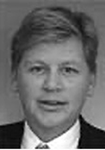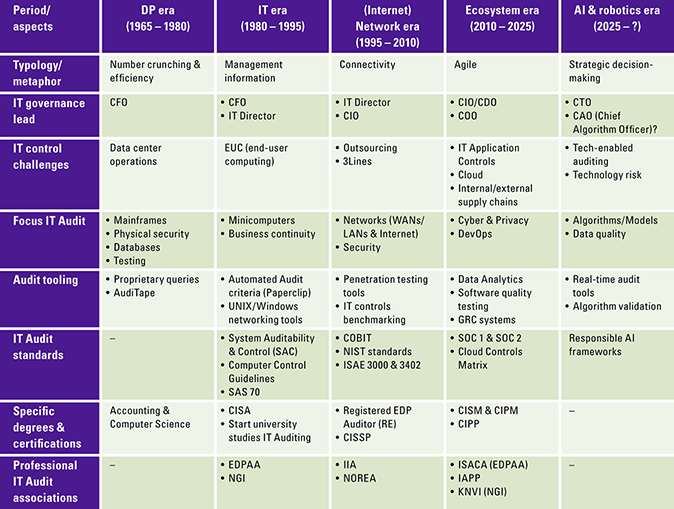To commemorate the fifty-year milestone of Compact, the acting Editor-in-Chief interviewed his three predecessors. The early years and history of fifty years of Compact are covered, as well as their expectations for the future of Compact as disseminator of knowledge and good practices.
Editors-in-Chief of Compact magazine

|
Dick Steeman, retired, Editor-in-Chief 1974 – 1994 |

|
Dries Neisingh, retired, Editor-in-Chief 1994 – 2002 |

|
Hans Donkers, ex-partner KPMG, founder WeDoTrust, Editor-in-Chief 2002 – 2015 |

|
Ronald Koorn, partner KPMG, Editor-in-Chief 2015 – current |
What were remarkable developments in your Compact era?
We started with Compact when the punch cards where still around, while financial institutions and multinationals began to use new IBM systems with keypunch and programming capabilities (S/360, S/3) that were far more efficient in automating their massive administrative processes. Initially, the accountants used their own computer “for auditing around the computer”. In the early days, the audit focus was on data centers and the segregation of duties within IT organizations.
The knowledge of programming lacked at accounting firms in the seventies, therefore we first wrote articles on programming, testing and data analytics for our Financial Audit colleagues. Clients such as Heineken, KLM and ABN AMRO were keen on obtaining Compact as well. That’s how the magazine expanded. Due to the influence of Herman Roos and KPMG’s Software Engineering unit, Compact articles also addressed more technical subjects. So, the target group broadened beyond financial/IT auditors to IT specialists, IT directors and CFOs/COOs.
A nice anecdote is that when we issued Compact editions internally within KPMG the first few years, we were even proactively approached by the publishing company Samsom (now Wolters Kluwer) to offer their services for publication and distribution. We contractually had to issue four editions annually, which was in some years challenging to accomplish – especially besides all regular work. In other years, we completed four regular editions as well as a Compact Special for upcoming IT-related developments, such as Euro migration, Y2K (Millennium), ERP systems or new legislation (e.g., Privacy and Computer Criminality).
In 2001, we’ve issued our first international Compact edition (coordinated by the interviewer), as we wanted to address international variations and best practices. It was distributed to 25 major KPMG countries for their clients. Although, several non-native English authors overestimate their English writing proficiency.
Compact has always been focused on exchanging good practices and organizations are quite keen on learning from leading companies and their peers. Therefore, we changed the model from a – partly paid – subscription model, where authors were paid as well, via a controlled circulation model to a publicly available magazine. Writing articles was also an excellent way for less experienced staff to dive into a subject and structure it well for (novice) readers to understand. Of course, we’ve also been in situations where we had to hunt for (original) copy and actively entice colleagues to showcase their knowledge and experience in order to adhere to our quarterly publishing schedule. Several authors never completed their epistle, but luckily we always managed to publish a full edition.
We’re all pleasantly surprised by the current depth and quality and that Compact survived this long!
The name Compact was derived from COMPuter & ACcounTant. What do you see as the future target audience?
Besides the traditional target groups of IT auditors, IT consultants and IT-savvy financial auditors, it is also very useful for students. They can supplement their theoretical knowledge with practical examples of how technology can be applied in a well-controlled manner in a business context. There still are very few magazines highlighting the subjects that Compact addresses, such as IT Governance and IT Quality.
At least accountants (CPAs) need to know about IT due to the criticality of their financial audits, they cannot entirely outsource that to IT auditors. They should also address in their Management Letter whether “IT is in Control”. Of course, Compact is and should remain a good medium for communicating good practices to CFOs, CIOs and CEOs. Sometimes this knowledge sharing can be achieved indirectly via an IT-savvy accountant.
A brief history of IT & IT Auditing
As the past fifty years have been addressed in multiple articles in this edition, we have tried to consolidate the main trends in a summary table. We have aligned this summary with the model in the article “Those who know their past, understand their future: Fifty years of information technology: from the basement to the board” elsewhere in this Compact edition.
Several developments passed through different decennia; we have only indicated in which phase the main genesis took place.
How can the Editorial Board further improve Compact?
Compact has survived where other magazines were terminated are just faded-out. For commercial IT magazines it’s challenging to sustain a viable revenue model. So it is recommended to keep Compact free-of-charge and objective, and to emphasize the thoroughness of IT Audit and IT Advisory work based on a foundation of factual findings. That is a real asset in this ever-changing IT domain, where several suppliers promise you a “cloud cuckoo land” and where ISO certifications are skin-deep. Furthermore, it is recommended to include articles written with clients as well as photographs to make it more personal.
More authors could showcase their deep expertise with articles, which also guarantees the inflow of articles and the continuity of Compact. Furthermore, you can leverage the network of all internal and external authors and their constituents to market the expertise of authors. For instance, besides informing C Level, accountants, IT consultants and IT auditors of relevant IT themes, you could also inform a broader group in society. In the past, Compact authors were interviewed for newspapers, TV, industry associations, etc.
About the Editors-in-Chief
Dick Steeman is a retired KPMG IT Audit partner in the Netherlands. Together with Han Urbanus, he established KPMG EDP Auditors and launched Compact. He was the Editor-in-Chief of Compact from 1974 until 1994.
Dries Neisingh is a retired KPMG IT Audit partner in the Netherlands. During his working life he was a Chartered Accountant, a chartered EDP Auditor and professor of auditing reliability and security aspect of IT at the University of Groningen. He was involved with Compact right from the first issue in 1974 and was the Editor-in-Chief from 1994 until 2002.
Hans Donkers used to be a partner at KPMG and is one of the founders of WeDoTrust. He was the Editor-in-Chief of Compact from 2002 until 2015.
Ronald Koorn is an active partner at KPMG in the Netherlands and has been the Editor-in-Chief of Compact since 2015.
Compact editors
Besides the Editors-in-Chief, we also wish to specifically thank the following editors with their Editorial Board tenure of at least ten years:
- Aad Koedijk
- Piet Veltman
- Rob Fijneman
- Brigitte Beugelaar
- Deborah Hofland
- Pieter de Meijer
- Peter Paul Brouwers
- Maurice op het Veld
- Jaap van Beek
And the Compact support staff over the decades: Henk Schaaf (editor), Sylvia Kruk, Gemma van Diemen, Marloes Jansen, Peter ten Hoor (publisher at Uitgeverij kleine Uil and owner of LINE UP boek en media), Annelies Gallagher (editor/translator), Minke Sikkema (editor), Mirjam Kroondijk and Riëtte van Zwol (desktop publishers).




